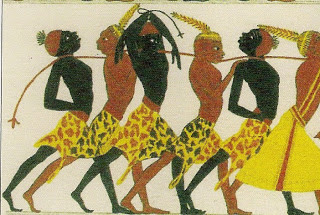Image found at Kuntillet Ajrud with a distincitve Nilotic style
Around 3000 years ago Kuntillet Ajrud was a typical high place. The biblical term "high place" refers to a shrine city at an elevated site, near a permanent water source. Other high places include Jerusalem, Jericho, Gobekli Tepe, and Catal Hoyuk.
Kuntillet was built on a hill with wells at the foot of the hill. Discoveries made at Kuntillet Ajrud in the northern Sinai point to a Nilotic point of origin for the Hebrew religion and worldview.
Another image found at Kuntillet Ajrud shows a seated female figure playing a harp in the background. In the forefront is a male figure wearing a leopard-skin tunic (shown below).
The men of the oldest known priest caste wore leopard skins. Similar images have been found at Catal Hoyuk in southern Anatolia dating to 7500 BC (See below).
The Turkish word "catal" means fork and "hoyuk" means mound. This settlement was built on two mounds (east-west axis) and a channel of the Çarşamba River once flowed between them. The houses excavated in Catal Hoyuk date between 6800-5700 B.C. Recent excavations have identified a shrine or small temple on the eastern side.
The Nubians wore leopard skin tunics. Petrie's study of ancient images suggested to him that Egypt was the product of different racial types. He found images of red and black Nubians. This confirmed what had been discovered by the 1828 Franco-Italian expedition to Egypt led by Jean-Francois Champollion and Ippolito Rosellini. Below is a detail from one of Rosellini's drawings showing both black and red Nubian captives taken by the Egyptians under Rameses II (BC 1279-1213).





No comments:
Post a Comment
Your comments are welcome. Please stay on topic and provide examples to support your point.